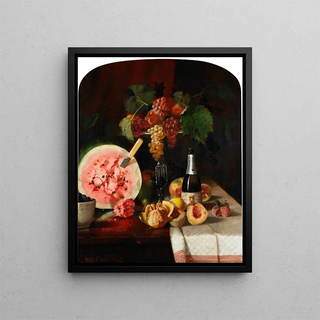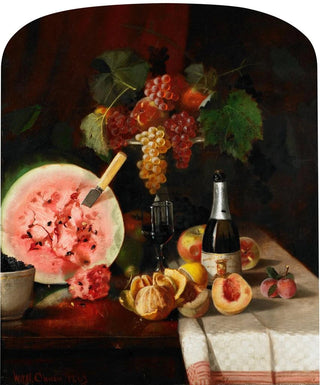Art print | Still life with watermelon - William Merritt Chase


View from behind

Frame (optional)
William Merritt Chase's watermelon still life is a work that transcends mere pictorial genre. It invites the viewer to immerse themselves in a universe where light and color meet in a harmonious dance. This visual composition, both delicate and vibrant, evokes a sense of freshness and vitality, capturing the very essence of summer fruits. Chase, with his keen eye, manages to infuse his subjects with an almost palpable life, transforming ordinary objects into true protagonists of an intimate and warm scene. The watermelon, with its juicy flesh and shades of bright red, becomes the focal point of a silent narration, inviting prolonged contemplation.
Style and uniqueness of the work
Chase's style is distinguished by his bold use of color and light. In this art print, he plays with shadows and reflections, creating an atmosphere that is both realistic and poetic. The textures of the fruits, leaves, and surfaces are rendered with such precision that they seem almost touchable. Each brushstroke reveals technical mastery that demonstrates his deep commitment to realism while flirting with impressionism. The composition, carefully balanced, guides the eye across the canvas, inviting exploration of every detail, every nuance. Chase does not merely depict nature; he gives it an emotional dimension, making each element an integral part of a broader visual narrative.
The artist and his influence
William Merritt Chase, an iconic figure of the American Impressionist movement, left his mark on his era through his innovative approach to painting. Born in 1849, he was influenced by the great European masters while developing a style that is uniquely his own. His work, particularly in the field of art print, paved the way for many artists, inspiring a new generation to explore light and color boldly. Chase was also a passionate teacher, sharing his knowledge and vision with his students, thus contributing to the emergence of a distinctive American style. His ability to capture the fleeting beauty of everyday objects has left an indelible imprint.

Matte finish

View from behind

Frame (optional)
William Merritt Chase's watermelon still life is a work that transcends mere pictorial genre. It invites the viewer to immerse themselves in a universe where light and color meet in a harmonious dance. This visual composition, both delicate and vibrant, evokes a sense of freshness and vitality, capturing the very essence of summer fruits. Chase, with his keen eye, manages to infuse his subjects with an almost palpable life, transforming ordinary objects into true protagonists of an intimate and warm scene. The watermelon, with its juicy flesh and shades of bright red, becomes the focal point of a silent narration, inviting prolonged contemplation.
Style and uniqueness of the work
Chase's style is distinguished by his bold use of color and light. In this art print, he plays with shadows and reflections, creating an atmosphere that is both realistic and poetic. The textures of the fruits, leaves, and surfaces are rendered with such precision that they seem almost touchable. Each brushstroke reveals technical mastery that demonstrates his deep commitment to realism while flirting with impressionism. The composition, carefully balanced, guides the eye across the canvas, inviting exploration of every detail, every nuance. Chase does not merely depict nature; he gives it an emotional dimension, making each element an integral part of a broader visual narrative.
The artist and his influence
William Merritt Chase, an iconic figure of the American Impressionist movement, left his mark on his era through his innovative approach to painting. Born in 1849, he was influenced by the great European masters while developing a style that is uniquely his own. His work, particularly in the field of art print, paved the way for many artists, inspiring a new generation to explore light and color boldly. Chase was also a passionate teacher, sharing his knowledge and vision with his students, thus contributing to the emergence of a distinctive American style. His ability to capture the fleeting beauty of everyday objects has left an indelible imprint.






